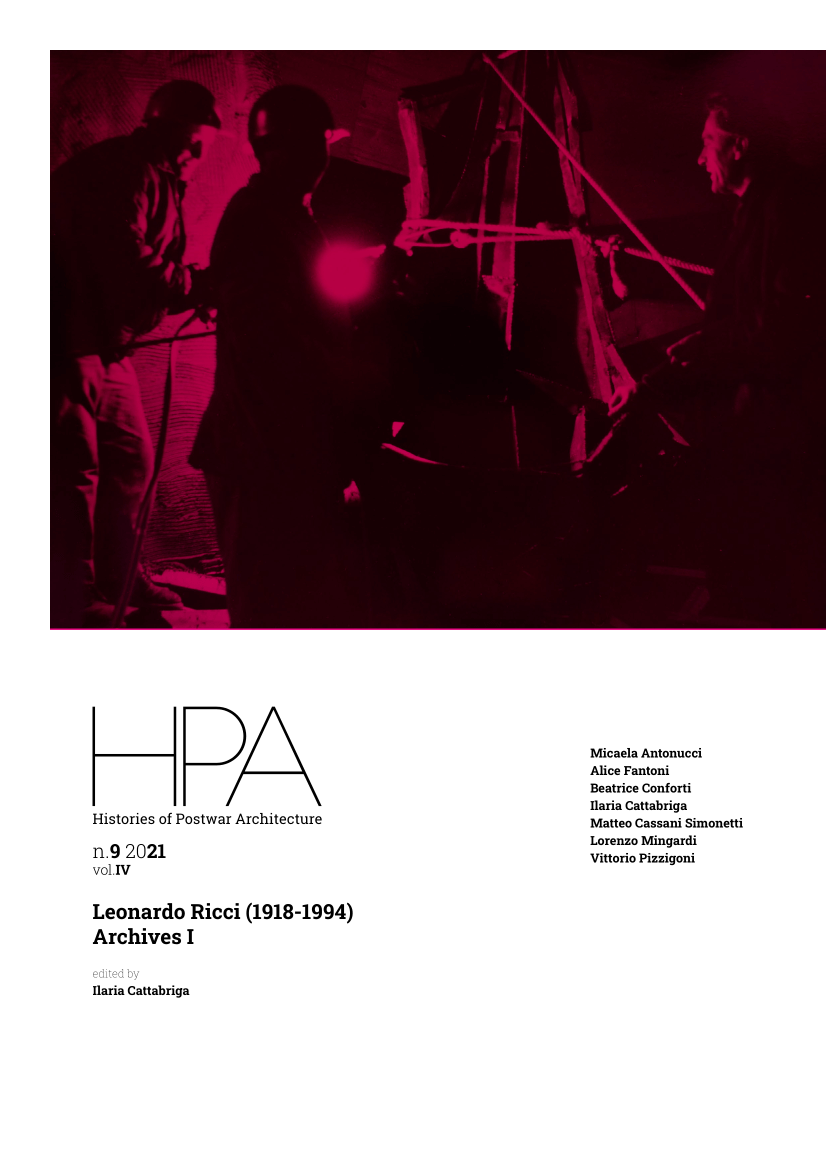Leonardo Ricci and the Project for the “Man-Machine Space”: the Goti Factory (1959)
DOI:
https://doi.org/10.6092/issn.2611-0075/16120Keywords:
Yarn factory, human activity, Leonardo Ricci, machine space, spatial researchAbstract
The Goti factory is a civil architecture, built between 1959 and 1960, when Ricci was managing to translate into reality some fundamental principles of his spatial research: the design method of the "form-act", the community ideal and the anonymous, relational and existential architecture. This text aims to frame the project in Ricci’s work and clarify these design ideals and how they are found in the analyzed project, exploiting the reading of archival sources and contemporary projects or with a similar program. Furthermore, the Goti Factory is placed in the years in which Ricci begins an intense exchange with the United States, which will allow him to approach the founding theories of Urban Design, therefore to resolve, thanks to them, that tension between opposites that animated his research, finally reaching the definitive evolution of his design method.
Downloads
References
Ricci, Leonardo. “Space in Architecture: the visual image of environment”, Journal of University of Manchester Architectural and Planning Society, no. 7 (1956): 7–11;
Koenig, Giovanni Klaus. “Leonardo Ricci e la ‘casa teorica’ (alla ricerca di un nuovo spazio architettonico)”, Bollettino Tecnico - Rassegna Bimestrale Fondata nell’Anno 1936, no.7–8 (1958): 3–12;
Lattes, Wanda. “Perchè è nata la fabbrica “bella”, Il Giornale del Mattino, July 31, 1960.
Ricci, Leonardo. Anonymous (XX century). New York: George Braziller, 1962;
Ricci, Leonardo. “Ricerche per una città non alienata”, Linea-Struttura, Rassegna Trimestrale di Architettura Arti Visive Design, no. 1–2 (1967): 39–51;
Koenig, Giovanni Klaus. Architettura in Toscana 1931-1968.Torino: ERI, 1968;
Ricci, Leonardo.“’New Towns’ a scala territoriale”, Spazio e Società, no. 3 (1976): 73–81;
Doglio, Carlo, and Paola Venturi. La pianificazione organica come piano della vita?. Padova: Cedam, 1979;
Nardi, Antonio. Leonardo Ricci. Testi, opere, sette progetti recenti di Leonardo Ricci. Pistoia: Edizioni del comune di Pistoia, 1982;
Lima, Antonietta Jolanda. “Leonardo Ricci: Riesi, un villaggio come un kibbutz = Riesi like a kibbutz”, L’Architettura: Cronache e Storia, no. 41 (1995): 406-21;
Zevi, Bruno. “Tra i due Leonardi fiorentini.” In Leonardo Savioli: il segno generatore di forma-spazio, catalogo della mostra (Firenze, Archivio di Stato, 23 September-25 November 1995). Città di Castello: Edimond, 1995.
Paci, Enzo. Relazioni e significati, Vol. III. Milano: Lampugnani Nigri, 1966;
Vasič Vatovec, Corinna. Leonardo Ricci. Architetto “esistenzialista”. Firenze: Edifir, 2005;
Scrivano, Paolo. Olivetti builds. Milano; Skira, Milano, 2001;
Biraghi, Marco, and Alberto Ferlenga, eds. Comunità Italia, Milano: Silvana Editoriale, 2015;
Ryan, Brent. The Largest Art. A Measured Manifesto for a Plural Urbanism. Cambridge-MA: MIT Press, 2017;
Piccardo, Emanuele, ed. Leonardo Ricci. Fare Comunità. Busalla: Plug_in, 2019;
Ghia, Maria Clara. La Nostra Città è tutta la Terra. Leonardo Ricci architetto (1918-1994). Wuppertal: Steinhauser Verlag, 2021.
Downloads
Published
How to Cite
Issue
Section
License
Copyright (c) 2021 Ilaria Cattabriga

This work is licensed under a Creative Commons Attribution 4.0 International License.





